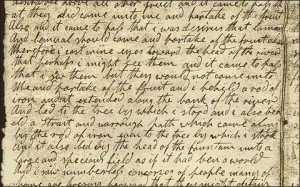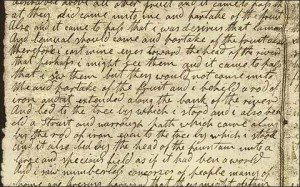
The original manuscript and printer’s manuscript of the Book of Mormon had no punctuation. The punctuation was added later by E. B. Grandin’s assistant, who was not a member of the Church.
Here is a Microsoft Word document I’ve created for anyone to download. It is the full text of the Book of Mormon with all the punctuation removed. Likewise, all capital letters have been changed to lowercase, except for proper names (e.g., Nephi, Moroni, Satan), the first person pronoun “I” and interjection “O,” and a handful of other proper nouns that seemed odd to leave lowercase (God, Lord, Christ, Messiah, Holy Ghost, Holy Spirit).
(The current version has these remaining capitalized words colored, just in case someone has some use for it. But if you don’t want them to be colored, simply select all [Ctrl A] and change it to black text.)
Click here to download the full text of the Book of Mormon with punctuation removed![]()
Why I made this document
I’ve done this because it more closely approximates what the original manuscript (and the printer’s manuscript) looked like as Joseph translated the Book of Mormon and Oliver Cowdery wrote it down. The original translation was “closely written and legible, but not a punctuation mark from beginning to end” (Porter, Ensign). “The man responsible for punctuating the first edition of the Book of Mormon was John H. Gilbert, the non-Mormon typesetter who worked for E. B. Grandin” (Horton, Ensign). Gilbert added both punctuation and paragraphing (Matthews, Ensign). Thus, while the translation was performed by a prophet based on inspiration, the paragraphing, sentence breaks, and punctuation were performed by a regular, educated man based on ordinary, mundane principles.
In many cases, a sentence can be interpreted differently depending on how it is punctuated. For example, in an unpunctuated Alma 37:23, the Lord says, “I will prepare unto my servant Gazelem a stone which shall shine forth.” Gazelem could be interpreted to be a name for a servant or for a stone; the text is ambiguous. Each interpretation would be punctuated differently:
- “I will prepare unto my servant, Gazelem, a stone which shall shine forth.” [Gazelem is a servant]
- “I will prepare unto my servant Gazelem, a stone which shall shine forth.” [Gazelem is a shining stone]

Funny how many possibilities are opened by looking at just the words Joseph translated and ignoring the things that were added later.
The current edition of the Book of Mormon is punctuated to favor the second interpretation of a stone, but the entry for “Gazelem” in the index assumes the first interpretation of a servant. The Church’s Book of Mormon Student Study Guide for Sunday School also uses the first interpretation, but it freely admits that it is only one possibility, using the qualifier “apparently” in its explanation. Neither interpretation is “revealed” or “authoritative” or doctrinally set in stone.
Thus, while the text of the Book of Mormon is divinely revealed, the punctuation is not. That can be important to keep in mind as we read the book. It helps us read more closely and it opens our eyes to new possible ways of understanding the prophets’ words. For a few more good examples, see Grant Hardy, “Of Punctuation and Parentage,” Insights v24 n2, Maxwell Institute.
How to use this document
This document allows you to read through the Book of Mormon and insert punctuation as it makes sense to you. Occasionally you’ll find passages with two or more possible interpretations. I don’t know that any of us are qualified to determine the correct meaning, but I think we can all be edified by reading the scriptures close enough to notice more possibilities. I’d love to know if anyone uses this document and how you used it. Feel free to tell us about it in the comments.

If you could put a link to this under the Gospel tab with the other ones, it would be really helpful. It took me a while to find this page again. I think it’s awesome, and I just directed 600 other women to your site. 🙂 One of my good friends started a “Read the BoM in 80 days” Facebook group, and I suggested that this might be a novel way to study the scriptures. I posted a direct link to this page, but you know how some people are. 🙂
Thanks, Jenny! I really hope some people try it—I think it’s a fabulous and really effective way to read the scriptures. Could you post here a link to that Facebook page so I can take a look?
With the current WordPress theme I’m using, I don’t know if there’s a way to post a direct link to a post, in the menus. However, on your advice, I added links to this post from the Do-It-Yourself Scriptures page, so I hope that helps you and others in the future.
By the way, have you seen my Do-It-Yourself files for the Book of Mormon? That’s another idea the members of that group may be interested in. It’s a less monumental task than repunctuating the entire book. Instead, all you do is insert paragraph breaks and headings wherever you think they make sense. I highly recommend it as a way to gain insights, especially if you’ve already read the Book of Mormon several times and are very familiar with it. Doing the custom paragraphs and headings helps you pay attention, read it with fresh eyes, and gain all new insights.
Here’s the link: https://www.facebook.com/groups/171379419731786/permalink/172019656334429/
Heidi is doing an amazing job.
I actually printed off this version a while back without adding in any punctuation. I think that I make changes every time I read!
PS: I love the Structured D&C and I used it this year in Sunday school. On that page, you had a picture that included the BoM done that way. Not that you are not busy with work and family and all those wonderful things, but if you get around to making that available, it would be great. Further, I know it’s a huge undertaking, but if ever the entire standard works was done, I would pay good money for a copy.
Amen about changing every time. I’m repunctuating the Book of Mormon right now, and I know it’s a document that will always be in flux. I hesitate to post it online, because I know it will be obsolete in my mind even a week later.
That makes my day to know that you found the Structured D&C useful! It’s very very helpful for me to hear how people are using it and what parts helped, because then I can tweak it or fine-tune it.
You have no idea how eager I am to finish the entire standard works. If I didn’t have to hold down a job and feed a family (heck, or have to eat and sleep), I know I could have it done within two years. The Book of Mormon is part-way done in draft form, and once I figure out how to upload such a ginormous file, I’ll post the link. A warning though: it’s very messy and ugly it its current form. The New Testament is mostly complete, especially the Acts and Revelation. I also have done most of Genesis, Judges, Kings, and Isaiah.
I tell you, Jenny, this project is what I think about all the time. It’s what I think about when I’m driving or in the shower. Every night, once the kids are down, I try to squeeze in 20 minutes here, 30 minutes there. I actually submitted the D&C to Deseret Book about a month ago; I should find out in January whether they want it.
By the way, Jenny, I’ve now posted (the current draft of) the Book of Mormon over on the Structured Edition page, so you can download it if you like.
Below is a link to a great reddit discussion regarding Alma 53:1. It questions the grammar and word choice of the verse and shows that the current English version differs significantly from foreign language translations. It also brings into play other similar verses in the Book of Mormon. Specifically, Book of Mormon usage of the term “of the” and the broader topic of possessive adjectives. I’d love others opinions regarding it. … Here’s the link:
http://www.reddit.com/r/latterdaysaints/comments/2497ro/over_the_prisoners_of_the_lamanites_longstanding/
Thanks for the heads-up Damon. I’m very eager to read it, and will respond in these comments when I have the chance. I always appreciate people passing along good links like this.
Pingback http://www.reddit.com/r/latterdaysaints/comments/28acns/the_book_of_mormon_without_punctuation/
Very interesting and helpful material. I have been wondering about the Book of Mormon, without punctuation, for some time—and here it is!
Anyone giving thought to noting chiastic structures in the Book of Mormon that verse numbering and punctuation obscure? Some, when noted, change one’s perspective when they are placed into full structure.
Thanks.
Hi there. Is this still something I can download? I’m assuming there might have been some copyright issues? I would love to read the Book of Mormon without punctuation or chapter breaks. I would especially love to listen to an audio of it! I learn a lot more listening than reading, sometimes.
Yes, you should be able to just click on the large Word icon in the green box and it will start the download. Is it not working for you? Are you viewing this page on a computer or a touchscreen device like a smart phone? Because sometimes on smart phones, the green download boxes don’t show up. Try viewing the page on a desktop or laptop computer instead.